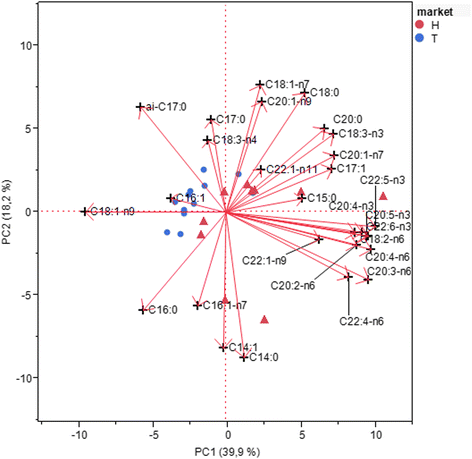At slaughtering and post mortem characteristics on Traditional market ewes and Halal market ewes in Tuscany
- PMID: 27606072
- PMCID: PMC5013581
- DOI: 10.1186/s40781-016-0116-2
At slaughtering and post mortem characteristics on Traditional market ewes and Halal market ewes in Tuscany
Abstract
Background: The aim of this work was the comparison between the carcass and the meat ewes of the regional Traditional market and the Islamic religious (Halal) market.
Methods: Thirty and 20 at the end of career traditional market and Halal market ewes were slaughtered following the EC (European Council, 2009) animal welfare guidelines. Live weight of ewes was taken and dressing percentage of carcasses was calculated. On every carcass zoometric measurement and the evaluation trough the EU grid rules were performed. On the Musculus longissimus thoracis of 12 Traditional market carcasses and 11 Halal market carcasses the physical-chemical and nutritional analysis were performed. Consumer tests for liking meat ewe were performed in order to find consumer's preference level for Traditional and Halal markets ewe meat. Considering as fixed factor the ewe meat market (Traditional and Halal), results were submitted to oneway Analysis of Variance (ANOVA) and to Principal Component Analysis (PCA).
Results: The Halal market ewes have shown lower dressing percentages (42.91 ± 0.82 vs 46.42 ± 0.69) and lower conformation score (4.5 ± 0.5 vs 7.8 ± 0.4). The Halal market meat showed higher cooking loss in oven (37.83 ± 1.20 vs 32.03 ± 1.15 %), lesser Chroma value (18.63 ± 0.70 vs 21.84 ± 0.67), and lesser Hue angle value (0.26 ± 0.02 vs 0.34 ± 0.02). This product had also lower fat percentage (4.2 ± 0.4 vs 7.09 ± 0.4). The traditional market meat had higher percentage in monounsatured fatty acids (MUFA) (43.84 ± 1.05 vs 38.22 ± 1.10), while the Halal market meat had higher percentage in ω3 poliunsatured fatty acids (PUFA) (5.04 ± 0.42 vs 3.60 ± 0.40). The consumer test showed as the ewe meat was appreciate by the consumers.
Conclusions: Both meat typologies have shown good nutritional characteristics. The traditional market meat had higher MUFA composition, and a better MUFA/satured fatty acids (SFA) ratio, while the Halal market meat had higher PUFA composition. These results were also supported by the PCA. The consumers preferred the traditional market meat.
Keywords: Carcass characteristics; Consumer test; Ewe; Halal market; Meat quality; PCA analysis; Traditional market.
Figures
Similar articles
-
Meat from cattle slaughtered without stunning sold in the conventional market without appropriate labelling: A case study in Italy.Meat Sci. 2017 Dec;134:1-6. doi: 10.1016/j.meatsci.2017.07.011. Epub 2017 Jul 18. Meat Sci. 2017. PMID: 28738224
-
Genetic correlation estimates between beef fatty acid profile with meat and carcass traits in Nellore cattle finished in feedlot.J Appl Genet. 2017 Feb;58(1):123-132. doi: 10.1007/s13353-016-0360-7. Epub 2016 Jul 30. J Appl Genet. 2017. PMID: 27475083
-
Religious slaughtering: Implications on pH and temperature of bovine carcasses.Saudi J Biol Sci. 2022 Apr;29(4):2396-2401. doi: 10.1016/j.sjbs.2021.12.002. Epub 2021 Dec 10. Saudi J Biol Sci. 2022. PMID: 35531228 Free PMC article.
-
Pros and cons of different stunning methods from a Halal perspective: a review.Transl Anim Sci. 2021 Oct 11;5(4):txab154. doi: 10.1093/tas/txab154. eCollection 2021 Oct. Transl Anim Sci. 2021. PMID: 34859198 Free PMC article. Review.
-
Safety, Quality and Analytical Authentication of ḥalāl Meat Products, with Particular Emphasis on Salami: A Review.Foods. 2020 Aug 13;9(8):1111. doi: 10.3390/foods9081111. Foods. 2020. PMID: 32823523 Free PMC article. Review.
References
-
- Tocci R, Campostrini M, Pippi E, Fratini R, Martini A, Sargentini C. Adult ovine meat marketing in Tuscany. Ital J Anim Sci. 2015;14 suppl 1:99.
-
- European Council 2009. Council regulation (EC) No 1099/2009 of 24 September 2009 on the protection of animals at the time of killing (Text with EEA relevance)
-
- Summary of conditions for Halal slaughter 2015. http://halalcertification.ie/Halal/islamic-method-of-slaughtering/.
-
- AA.VV. Stordimento e abbattimento degli animali durante la macellazione tramite elettronarcosi 2001. http://www.pubblicitaitalia.com/eurocarni/2001/8/3320.html
LinkOut - more resources
Full Text Sources
Other Literature Sources



